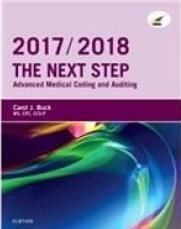
The Next Step Advanced Medical Coding and Auditing 2017- 2018 1st Edition by Carol Buck
Edition 1ISBN: 978-0323430777
The Next Step Advanced Medical Coding and Auditing 2017- 2018 1st Edition by Carol Buck
Edition 1ISBN: 978-0323430777 Exercise 1
Case 9-1
LOCATION: Outpatient, Hospital
PATIENT: Harold White
ATTENDING PHYSICIAN: Jeff King, MD
SURGEON: Jeff King, MD
PREOPERATIVE DIAGNOSES
1. Left true vocal cord mass.
2. Hoarseness.
3. Asthma.
4. Gastroesophageal reflux disease.
POSTOPERATIVE DIAGNOSIS: Same as Preoperative.
OPERATIVE PERFORMED: Direct laryngoscopy with use of operating microscope for excision of a left anterior true vocal cord mass.
ANESTHESIA: Endotracheal.
INDICATIONS: A 65-year-old male with chronic hoarseness. He has a long-term history of tobacco use but finally was able to quit 2 years ago. Examination reveals a mass involving the anterior portion of the left true vocal cord. The patient also has a history of asthma and reflux disease.
PROCEDURE: After consent was obtained, the patient was taken to the operating room and placed on the operating room table in the supine position. After an adequate level of general endotracheal anesthesia was obtained, the patient was positioned for direct laryngoscopy. The laryngoscope was placed in position. There were no lesions in the oropharynx or hypopharynx. This was placed into the suspension. The microscope was then brought in. An exophytic mass was noted involving the anterior third of the left true vocal cord extending to the area of the anterior commissure. Utilizing the forceps and the micro scissors, the mass was excised. Hemostasis was achieved with pledgets soaked with 1:100,000 units of epinephrine. The laryngoscope was then removed and the patient turned over to anesthesia. The patient tolerated the procedure well, and there was no break in technique. The patient was extubated and taken to the postanesthetic care unit in good condition.
Pathology Report Later Indicated: Adenocarcinoma, poorly diffused, primary.
FLUIDS ADMINISTERED: 1000 cc of RL
ESTIMATED BLOOD LOSS: Less than 5 cc.
PREOPERATIVE MEDICATIONS: 12 mg of Decadron and 20 mg of Pepcid IV.
CPT Code(s): _________________
ICD-10-CM Code(s): _________________
Abstracting Questions:
1. Was the laryngoscopy direct or indirect? _________________
2. Does the use of the operating microscope affect code assignment? _________________
3. What other factor affected code assignment? _________________
4. The primary diagnosis was identified based on what report? _________________
5. Do the diagnosis codes differentiate between true and false vocal cords? _________________
LOCATION: Outpatient, Hospital
PATIENT: Harold White
ATTENDING PHYSICIAN: Jeff King, MD
SURGEON: Jeff King, MD
PREOPERATIVE DIAGNOSES
1. Left true vocal cord mass.
2. Hoarseness.
3. Asthma.
4. Gastroesophageal reflux disease.
POSTOPERATIVE DIAGNOSIS: Same as Preoperative.
OPERATIVE PERFORMED: Direct laryngoscopy with use of operating microscope for excision of a left anterior true vocal cord mass.
ANESTHESIA: Endotracheal.
INDICATIONS: A 65-year-old male with chronic hoarseness. He has a long-term history of tobacco use but finally was able to quit 2 years ago. Examination reveals a mass involving the anterior portion of the left true vocal cord. The patient also has a history of asthma and reflux disease.
PROCEDURE: After consent was obtained, the patient was taken to the operating room and placed on the operating room table in the supine position. After an adequate level of general endotracheal anesthesia was obtained, the patient was positioned for direct laryngoscopy. The laryngoscope was placed in position. There were no lesions in the oropharynx or hypopharynx. This was placed into the suspension. The microscope was then brought in. An exophytic mass was noted involving the anterior third of the left true vocal cord extending to the area of the anterior commissure. Utilizing the forceps and the micro scissors, the mass was excised. Hemostasis was achieved with pledgets soaked with 1:100,000 units of epinephrine. The laryngoscope was then removed and the patient turned over to anesthesia. The patient tolerated the procedure well, and there was no break in technique. The patient was extubated and taken to the postanesthetic care unit in good condition.
Pathology Report Later Indicated: Adenocarcinoma, poorly diffused, primary.
FLUIDS ADMINISTERED: 1000 cc of RL
ESTIMATED BLOOD LOSS: Less than 5 cc.
PREOPERATIVE MEDICATIONS: 12 mg of Decadron and 20 mg of Pepcid IV.
CPT Code(s): _________________
ICD-10-CM Code(s): _________________
Abstracting Questions:
1. Was the laryngoscopy direct or indirect? _________________
2. Does the use of the operating microscope affect code assignment? _________________
3. What other factor affected code assignment? _________________
4. The primary diagnosis was identified based on what report? _________________
5. Do the diagnosis codes differentiate between true and false vocal cords? _________________
Explanation
The Next Step Advanced Medical Coding and Auditing 2017- 2018 1st Edition by Carol Buck
Why don’t you like this exercise?
Other Minimum 8 character and maximum 255 character
Character 255


